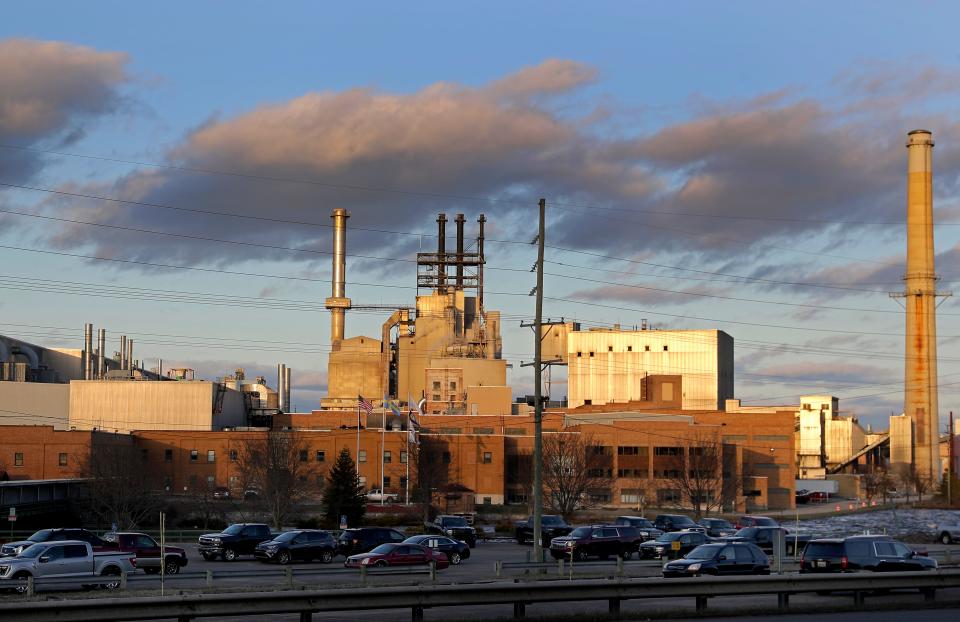A rare fungal infection broke out at a paper mill. Here's what to know about blastomycosis in Wisconsin.
Authorities are still trying to determine how a recent fatal outbreak of a rare fungal disease at a paper mill in the Upper Peninsula happened.
"It's the largest known blastomycosis outbreak in U.S. history," the Detroit Free Press reported April 23.
While it's a relatively uncommon disease, the fungus that causes blastomycosis is endemic in Wisconsin, and the state is considered a "hot spot" for the fungal infection, according to Dr. Bruce Klein, a professor at the University of Wisconsin-Madison, who's researched blastomycosis for decades.
Over the years, there have been multiple blastomycosis clusters and outbreaks reported, mostly in the northern half of Wisconsin, according to Dr. Suzanne Gibbons-Burgener, mycotic diseases program coordinator with the Wisconsin Department of Health Services.
The Wisconsin DHS is monitoring the ongoing investigation in Escanaba, and "we are collaborating with public health professionals at the Michigan Department of Health and Human Services," Gibbons-Burgener said.

What happened in Michigan?
One person died and roughly 100 people were affected by the blastomycosis outbreak at the Billerud paper mill in Escanaba, the Detroit Free Press reported in mid-April.
"The first cases involving employees at the Billerud plant were diagnosed early last month, presenting as atypical pneumonia," the article states. "... All of those infected are either contractors, employees or visitors to the Billerud Paper Mill."
The mill closed temporarily as authorities investigate and perform a deep cleaning of the facility.
More: As mystery of Escanaba paper mill's blastomycosis outbreak deepens, its victims try to heal
What is blastomycosis?
Blastomycosis is an uncommon illness caused by a fungus so small it cannot be seen by the human eye, according to the Wisconsin DHS.
The fungus, Blastomyces, lives in the environment, particularly in moist soil and in decomposing matter, such as wood and leaves, according to the Centers for Disease Control and Prevention.
When dirt is disturbed, the fungus can get into the air, and people and animals may breathe it in. After the spores enter the lungs, a person's body temperature allows the spores to transform into yeast. In some cases, blastomycosis can spread outside of the lungs to other parts of the body, most commonly to the skin, bone, genitourinary tract and central nervous system, Klein said.
"Blastomycosis doesn't spread between people or between people and animals through the air," according to the CDC.
What are the symptoms of blastomycosis?
Symptoms include fever or chills, cough, night sweats, shortness of breath, chest or back pain, skin sores that look crusted or get bigger, fatigue and extreme tiredness, weight loss and muscle aches or joint pain, according to the CDC and Wisconsin DHS.
"Approximately 50% of people who inhale the spores either don't become ill or develop a mild, self-resolving respiratory illness," Gibbons-Burgener said. "Symptoms can occur two to 15 weeks after breathing in the fungal spores."
People who think they may have blastomycosis should contact their health care provider. There are diagnostic tests and treatments available for humans and pets, Gibbons-Burgener said.

Where is the fungus found?
Most cases occur in the United States or Canada, according to the CDC.
In the United States, the fungus "mainly lives in the Midwestern, south-central, and southeastern states, particularly in areas surrounding the Ohio and Mississippi River valleys, the Great Lakes, and the Saint Lawrence River" the CDC said.
How common is blastomycosis?
In states where blastomycosis is reportable, yearly incidence rates are approximately 1 to 2 cases per 100,000 population, the CDC said.
Wisconsin reports "the highest incidence of Blastomyces infection in the country," according to the CDC's Morbidity and Mortality Weekly Report in March.
From 2016 to 2020, the average annual number of reported blastomycosis cases in Wisconsin was 116, ranging from 101 cases during 2019 to 133 in 2017, according to Gibbons-Burgener. The statewide average annual incidence rate during that time period was two cases per 100,000 Wisconsin residents.
Blastomycosis contributed to the deaths of 61 patients during that five-year span, which is consistent with Wisconsin's previously observed 10% case fatality rate, according to Gibbons-Burgener.
"Blastomycosis is more likely to be diagnosed and reported to public health in patients with moderate to severe illness, so the overall case fatality rate should be lower when accounting for unreported cases of mild illness," she said.
Why is Wisconsin a 'hot spot'?
"I don't think anybody has really gotten to the root cause," said Klein, with UW-Madison.
The fungus flourishes in habitats that are prevalent in Wisconsin, he said, with its many lakes, rivers and streams, where people like to go fishing, canoeing and hunting. That said, other states have similar conditions, according to Klein.
It may also have to do with the fact that Wisconsin is one of only a handful of states where blastomycosis is a required notifiable disease.
"The fact that we're watching and require reporting, this may have something to do with the apparent increased incidents," Klein said. "But there is something about Wisconsin, just aside from the increased reporting, that I think is responsible for us being the hot spot in certain parts of the state."

Has an outbreak happened at a paper mill before?
What happened at the Escanaba paper mill is "unusual" and appears to be "unprecedented," Klein said.
"I'm not aware of any prior outbreak in a setting like that," he added.
Given Wisconsin's many paper mils and that blastomycosis is carefully tracked here, "I'm sure it would have come to attention previously" if an outbreak had happened, Klein said.
Transmission usually occurs outdoors, so the Escanaba mill outbreak "is unusual because exposure to Blastomyces spores possibly occurred indoors during winter months," according to Gibbons-Burgener.
Still, at this time, the Wisconsin DHS believes "that exposure to Blastomyces during indoor activities at home or in a building is very unlikely," she said.
On April 15, the United Steelworkers union called for testing and cleaning in paper mills across the industry.
"What happened in the Escanaba facility reinforces the need to be proactive with occupational health and safety, and the best way to prevent another outbreak is to institute safeguards before anyone else encounters this disease at work," a USW spokesperson told The Post-Crescent in an email on April 20.
"Our union continues to work with the company and national health and safety experts to determine the cause of the outbreak in Escanaba, which will help inform further efforts to keep all workers safe," the email states.
More: Why tissue, packaging and specialty papers look promising for Wisconsin's paper industry
How are Wisconsin paper mills responding?
The Post-Crescent asked paper mills in the state if they were monitoring the Escanaba and if they are responding in any way.
Cascades, which has a tissue facility in Eau Claire, said "physicians from our Health Center of Excellence" are monitoring developments and recommendations. "At this time, it is not our intention to test our employees," a spokesperson said in an email on April 20.
"Our internal audit team meets regularly and plans to discuss what is learned from this situation and make any necessary adjustments to our cleaning and testing procedures," said Ryan Day, plant manager at BPM Inc., which has a mill in Peshtigo.
Ahlstrom's four Wisconsin plants in Rhinelander, Mosinee, Kaukauna and De Pere "undertake housekeeping measures on a regular basis," and "we are confident in our health and safety measurers at this time," while monitoring what happens in Michigan, a spokesperson said.
"We are sending our thoughts and support to the Escanaba team," the spokesperson said in an email.
More: Here's how some Wisconsin paper mills have remained family or locally owned amid industry shifts
What types of blastomycosis cases have happened in Wisconsin?
One person died and dozens of cases were reported from a blastomycosis outbreak in 2015 after people went tubing on the Little Wolf River near New London. Two people died from blastomycosis in Lincoln County in 2006 and 2010. Around 2009 and 2010, Marathon County experienced 55 cases, with 30 hospitalizations and two deaths.
A police dog with the Kronenwetter Police Department, Officer Chip, died of the disease in 2012. And in 2022, a veterinarian in St. Croix County helped identify a cluster of cases among dogs and humans.
Scientists at the Marshfield Clinic found that people with certain ethnic and racial backgrounds may need more aggressive treatment and closer monitoring for blastomycosis infection, according to a 2019 news release. Another study from the UW School of Medicine and Public Health determined that a specific genetic variation among Hmong people makes them more likely to get sick from blastomycosis.
A lot of progress has been made, but like many fungal infectious diseases, there's still more to learn about blastomycosis, Klein said, including about how to reliably diagnose an infection quickly, as well as how to to detect the organism in the environment.
Researchers are also still working to better understand, he said, why some people develop a progressive infection, while others have little to no symptoms at all.
Can you prevent getting blastomycosis?
"People are most at risk for blastomycosis if they move soil, especially near waterways, that has not been disturbed for a long time," Gibbons-Burgener said.
The CDC and Wisconsin DHS recommend people be aware and cautious during activities such as excavation, landscaping, off-path exploring or recreating along a waterway. You can take precautions to protect yourself, she said, by wearing a well-fitted mask.
"There is currently no consistent way to identify areas where the organism grows," Gibbons-Burgener said. "Testing for the fungus in soil or the environment is rarely successful, and only attempted for research or investigation purposes."
In general, "it's always good to have heightened awareness for this fungal infection in Wisconsin," Klein said.
More information about blastomycosis can be found at dhs.wisconsin.gov/disease/blastomycosis.htm and cdc.gov/fungal/diseases/blastomycosis/.
Reach Becky Jacobs at bjacobs@gannett.com or 920-993-7117. Follow her on Twitter at @ruthyjacobs.
This article originally appeared on Appleton Post-Crescent: Wisconsin monitors blastomycosis outbreak at Escanaba paper mill

